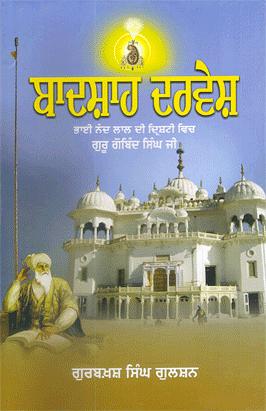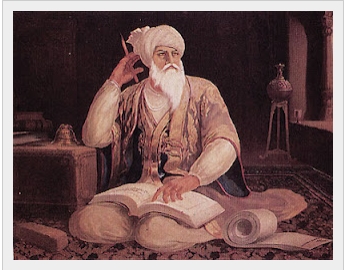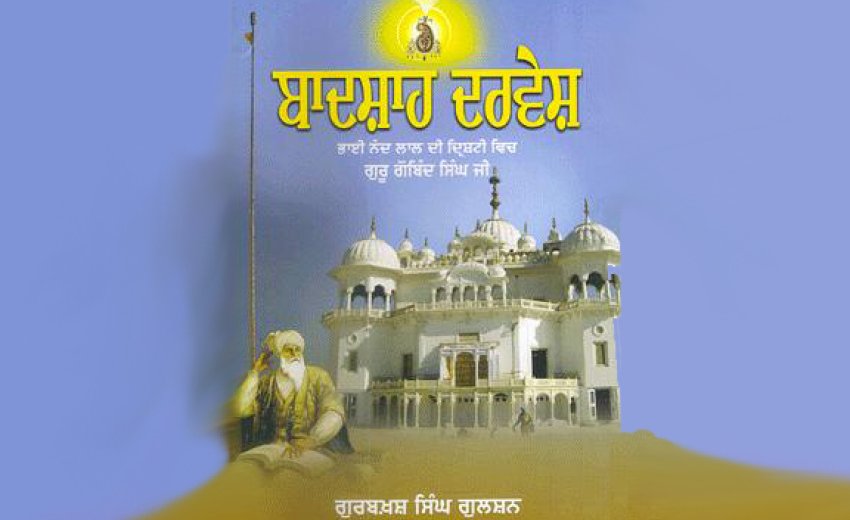 BADSHAH
DARVESH: Guru Gobind Singh as Bhai Nand Lal saw him. 2013. Translated by Gyani
Gurbax Singh Gulshan, 213 Pages. ISBN
978-0-9575859-0-4. Khalsa Parcharak Jatha (Barking, Essex, UK). Available from: Singh Bros, Amritsar, India.
Price Rs 200/Pounds 6. 00/US$10.00.
BADSHAH
DARVESH: Guru Gobind Singh as Bhai Nand Lal saw him. 2013. Translated by Gyani
Gurbax Singh Gulshan, 213 Pages. ISBN
978-0-9575859-0-4. Khalsa Parcharak Jatha (Barking, Essex, UK). Available from: Singh Bros, Amritsar, India.
Price Rs 200/Pounds 6. 00/US$10.00.
I.J. Singh
Readers know that I rarely review books written in any language other than English. But this book is unusual and deserves attention. It is a firsthand contemporary account by Nand Lal of how he viewed Guru Gobind Singh.
An iconic figure in Sikh history, ideology and tradition, Bhai Nand Lal, was a contemporary of Guru Gobind Singh and personally witnessed the life altering events of Vaisakhi 1699 that gave us the institution of the Khalsa. A scholar of Persian (Farsi) which was then the court language of India; Nand Lal wrote beautiful poetry in it. Bhai, meaning brother, is a title lovingly bestowed on him by the community. In Sikh tradition it is high praise indeed.
Of the 52 poets that made their home in Guru Gobind Singh’s entourage and royal court Nand Lal was numero uno – the supremo – the poet laureate. He forged a very personal relationship with Guru Gobind Singh and saw the Guru as both Patshah (from Badshah meaning King Emperor) and Darvesh (Prophet); hence the title of this book.
Nand Lal’s standing in Sikh ethos shines in history by the fact that he was present when Guru Gobind Singh instituted the order of the Khalsa. There is no credible evidence to indicate the he himself became Nand Singh during those dramatic days, even though some scholars suggest that he may have. On the other hand it is clear that he held numerous and lengthy, very personal and philosophic, exchanges with Guru Gobind Singh and, in spirited Persian poetry, recorded his impressions of what values and lifestyle Guru Gobind Singh expected of his Khalsa. His poetry remains some of the best evidence of those events.
On these matters rests his unique status in Sikh psyche. In fact, the only liturgy and poetry that is sung in the Sanctum Santorum at the Harmander Sahib (Golden Temple) at Amritsar is either from the Guru Granth, poetry of Guru Gobind Singh from the Dasam Granth, compositions of Bhai Gurdas, or the writings of Bhai Nand Lal. Nothing else may be recited there.
This book by Gurbax Singh Gulshan carries a brief biographical note on Nand Lal as well which is helpful in getting a handle on the man.
His was a colorful life. Nand Lal was a respected intellectual in the service of the Emperor, Aurungzeb, the arch enemy of Sikhs and Sikhi. Nand Lal’s father seems to have been a scholar of Farsi and Arabic and the son acquired a love for the languages.
 When the Emperor Shah Jehan (father of Aurungzeb) dispatched
his eldest son Dara Shikoh on an expedition to Kandhar Nand Lal’s father was in
his entourage. Both his parents died early
and Nand Lal returned to Multan in Punjab where he came under Sikh
influence. In 1682 he came to Anandpur
(Chak Nanki then) and met Guru Gobind Singh.
Nand Lal went on to Agra with Prince Muazzam, son of the emperor
Aurungzeb where he distinguished himself and came to the emperor’s attention by
correctly explicating a part of the Koran in 1695. Aurungzeb pressured Nand Lal
to embrace Islam so Nand Lal absconded to seek shelter in the encampment of
Guru Gobind Singh.
When the Emperor Shah Jehan (father of Aurungzeb) dispatched
his eldest son Dara Shikoh on an expedition to Kandhar Nand Lal’s father was in
his entourage. Both his parents died early
and Nand Lal returned to Multan in Punjab where he came under Sikh
influence. In 1682 he came to Anandpur
(Chak Nanki then) and met Guru Gobind Singh.
Nand Lal went on to Agra with Prince Muazzam, son of the emperor
Aurungzeb where he distinguished himself and came to the emperor’s attention by
correctly explicating a part of the Koran in 1695. Aurungzeb pressured Nand Lal
to embrace Islam so Nand Lal absconded to seek shelter in the encampment of
Guru Gobind Singh.
Nand Lal authored a book of Farsi poetry, Bandgi Nama (Ode to Bondage! The word bandagi can have a variety of meanings -- bondage, servitude or extreme loyalty), and presented it to the Guru who renamed it Zindgi Nama – Ode to Life. Nand Lal was a prolific and talented poet; his other writings include Diwan-E-Goya; Tehsif O’ Sana; Jote Bigaas; Gunj Nama; Rehat Nama and Tankhah Nama. After 1705 Nand Lal returned to Multan and reputedly ran a school for kids. He died sometime around 1713.
His work falls into three genres: 1. Poetry that has to do with general but catchily rendered commentary on life -- its travails and pleasures; 2. An unmatched tribute to Guru Gobind Singh – the man and the Guru, his character and worldview; and finally 3. Via conversations with Guru Gobind Singh an unusual, nay, unique historical window into what fundamentally is to be the lifestyle of the Khalsa.
The problem is that Nand Lal wrote in Farsi (Persian), a language that was the official language of India then but is now no longer taught in schools anywhere in the world except perhaps in Iran. It is melodic to the ear but requires translation to connect to the mind, and there is a new generation of Sikhs that has never heard of it or thought about it.
Gyani Gurbax Singh Gulshan – Gyani is a title like “Doctor” for a scholar of Punjabi and Sikh literature – presents translations of Ganj Nama; it is poetry that is essentially an ode to Guru Gobind Singh and his persona. But even that body of work would make a massive volume. Gulshan aims to whet our appetite via selections that he has made. It is these 57 couplets that Gulshan has translated here.
I have to confess that even though I am unschooled in Farsi, reading this developed in me some appreciation of the musical meter of Farsi and a taste of poesy that transcends the meaning or intellectual engagement. The poetry of Bhai Nand Lal is distinguished by a flowing rhythmic cadence.
Gulshan first presents each couplet in the original Persian and then transliterates it into Gurmukhi script so that a reader ignorant of Farsi can correctly read and enjoy the hypnotic rhythm. This is followed by brief word-to-word translations of key words into English. Then Gulshan presents a translation of the whole verse into serviceable modern English prose.
Next is a rendering of the original text (Farsi) into Gurmukhi script, followed by translation of difficult words into colloquial Punjabi. Then comes a translation of the verse in commonly spoken Punjabi prose. The next page, or sometimes two, presents a brief discourse and exegesis (katha) in Punjabi with references from Guru Granth Sahib and other Sikh sources; this commentary on each couplet is in chaste and literary Punjabi thus framing and enriching the verse and its significance.
The book is elegantly produced but it does have a few examples of the printer’s devil. The last chapter is a glossary of terms that is most helpful
In an earlier seminal work Gurbax Singh Gulshan traced the history of the modern Sikh Code of Conduct (Sikh Rehat Maryada) and how it was derived. It remains a most useful and definitive work on an important issue in Sikh tradition. It is significant that he has now focused on Bhai Nand Lal’s writings because his conversations with Guru Gobind Singh form a Rehat Nama that constitutes perhaps the most significant source document on the underpinnings of the modern code of conduct (Rehat Maryada) of the Sikhs.
I urge Gurbax Singh Gulshan to focus on the Rehat Nama and related writings of Bhai Nand Lal; it would be widely appreciated by friends and scholars of Sikhi.
Keep in mind that translation from one language to another is not a simple matter, particularly when the text was written centuries ago in a different cultural context. Usage changes words and their application over time. The ability to seamlessly move back and forth between cultures, languages and time is difficult and rare. To capture elegance, grace and precision in one language and transfer it to another is a miracle, found rarely and only in grace.
In this work the English is literal and sometimes awkward or stilted. Despite this caveat it remains a very useful and important body of work by Gyani Gurbax Singh Gulshan; it would have benefited and enhanced its appeal immensely by the collaboration of someone more adept with the English language.
In closing I offer you two couplets from the Ganj Nama along with translations by Gurbax Singh Gulshan:
Bar do aalam dast-e Gur Gobind Singh; Jumla ulvi pest-e Gur Gobind Singh.
Guru Gobind Singh has his blessed hand on both worlds; All the angels cannot be compared to Guru Gobind Singh.
Another couplet with Gulshan’s translation:
Qaadir-e Har Kaar Guru Gobind Singh; Be-Kasan Ra Yaar Guru Gobind Singh
Guru Gobind Singh is the most efficient in every respect; Guru Gobind Singh is a real friend of helpless and poor people.
November 1, 2013






